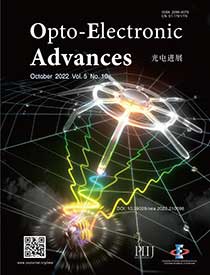2022 Vol. 5, No. 10
Cover story: Leal-Junior A, Avellar L, Biazi V, Soares MS, Frizera A et al. Multifunctional flexible optical waveguide sensor: on the bioinspiration for ultrasensitive sensors development. Opto-Electron Adv 5, 210098 (2022)
Since the earliest scientific developments, researchers look to the nature as an inspiration source for the design of novel functional devices. Recently, research groups of Professor Arnaldo Leal-Junior (Federal University of Espírito Santo, Brazil) and Professor Carlos Marques (University of Aveiro, Portugal) reported the development of an Ultrasensitive Flexible Optical Waveguide Sensor bioinspired by orb webs, also known as bioinspired multifunctional flexible optical sensor (BioMFOS). By using transparent resins with both mechanical and optical properties for structural integrity and strain/deflection transmission as well as the optical signal transmission properties with core/cladding configuration of a waveguide, the BioMFOS has small dimensions (around 2 cm) and lightweight (0.8 g), suitable for wearable application and clothing integration with ultra-high sensitivity and resolution, where forces in μN scale and the location of the applied force with a sub-millimeter spatial resolution can be detected . The sensor is integrated in clothing for respiration monitoring as well as movement analysis such as trunk and finger positions, depending on the BioMFOS positioning with a correlation coefficient higher than 0.9 when compared with a gold-standard inertial measurement unit. Thus, the proposed multifunctional device opens new avenues for novel bioinspired photonic devices and can be used in many applications of biomedical, biomechanics, and micro/nanotechnology.
Back cover story: Qi HX, Du ZC, Hu XY, Yang JY, Chu SS et al. High performance integrated photonic circuit based on inverse design method. Opto-Electron Adv 5, 210061 (2022)
The basic indexes of all-optical integrated photonic circuits include high-density integration, ultrafast response and ultra-low energy consumption. Traditional methods mainly adopt conventional micro/nano-structures. The overall size of the circuit is large, usually reaches hundreds of microns. Besides, it is difficult to balance the ultrafast response and ultra-low energy consumption problem, and the crosstalk between two traditional devices is difficult to overcome. Recently, Professor Xiaoyong Hu at Peking University proposed and experimentally demonstrated an approach based on inverse design method to realize a high-density, ultrafast and ultra-low energy consumption integrated photonic circuit with two all-optical switches controlling the input states of an all-optical XOR logic gate. The feature size of the whole circuit was only 2.5 μm×7 μm, and that of a single device was 2 μm×2 μm. The distance between two adjacent devices was as small as 1.5 μm, within wavelength magnitude scale. Theoretical response time of the circuit was 150 fs, and the threshold energy was within 10 fJ/bit. The research group also considered the crosstalk problem. The circuit also realized a function of identifying two-digit logic signal results. The work provides a new idea for the design of ultrafast, ultra-low energy consumption all-optical devices and the implementation of high-density photonic integrated circuits.

-
{{article.year}}, {{article.volume}}({{article.issue}}): {{article.fpage | processPage:article.lpage:6}}. doi: {{article.doi}}{{article.articleStateNameEn}}, Published online {{article.preferredDate | date:'dd MMMM yyyy'}}, doi: {{article.doi}}{{article.articleStateNameEn}}, Accepted Date {{article.acceptedDate | date:'dd MMMM yyyy'}}CSTR: {{article.cstr}}
-
{{article.year}}, {{article.volume}}({{article.issue}}): {{article.fpage | processPage:article.lpage:6}}. doi: {{article.doi}}{{article.articleStateNameEn}}, Published online {{article.preferredDate | date:'dd MMMM yyyy'}}, doi: {{article.doi}}{{article.articleStateNameEn}}, Accepted Date {{article.acceptedDate | date:'dd MMMM yyyy'}}CSTR: {{article.cstr}}

 E-mail Alert
E-mail Alert RSS
RSS



